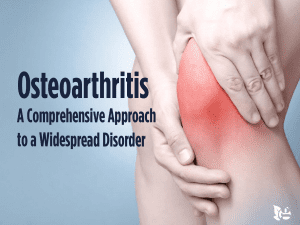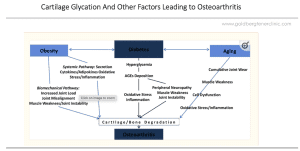28 Dec Osteoarthritis: A Comprehensive Approach


Paul A. Goldberg MPH, DC, DACBN, DCBCN
Founder and Consultant to The Goldberg Tener Clinic
Chronic Disease Reversal
Health Care Practitioners have been widely misinformed as to the causes of “Osteoarthritis” and how to address it. Millions of patients have received inappropriate information and care from their health care providers leading to ongoing disability that might have been prevented.
Osteoarthritis afflicts over 32.5 million Americans[1] and is the most common cause of disability in the United States, causing great suffering and financial loss. It is a public health and clinical issue that has been given insufficient attention and failed miserably to bring adequate care to those afflicted.
Osteoarthritis Defined
The traditional perspective on Osteoarthritis is that it is a mechanical form of “wear and tear” arthritis, as opposed to other forms of arthritis that are systemic, metabolic and or autoimmune in nature e.g. Rheumatoid Arthritis.
This simplistic categorization has led physicians to view patients with Osteoarthritis as having a condition that is an inevitable part of aging. Patients are administered anti-inflammatories, physical therapy and, in time, joint replacement as the expected course of action for this life altering disorder. This mis-understanding of Osteoarthritis as simply being the result of wear and tear has led patients resigning themselves to suffering with progressive disability without understanding the causal factors involved and what effective steps can be taken to prevent its occurrence and address it once established.
An analysis of the etiological factors involved with Osteoarthritis reveals the following underlying issues present in varying degrees depending on the individual patient.
Bio-Mechanical Issues
Bio-mechanical issues can play a significant role in the evolution of Osteoarthritis. Imbalances of the feet, legs, pelvis and supporting muscle groups can result in degeneration of the joints including the knees and hips which can be transferred to problems in the spine and shoulders.
A patient history of athletic activities such as distance running or heavy physical labor can play a role in osteoarthritic development if bio-mechanical imbalances are present An analogy would be a car’s tires. If the alignment of the tires is good the tires might last forty to sixty thousand miles. The same set of tires, however, if the wheels are misaligned, will wear out far more rapidly.
Bio-mechanical issues call for a practitioner versed in correcting structural imbalances. Doctors of Chiropractic and/or Sports Podiatrists, trained in the relationships between structure and function, are logical choices. Attention to the patient’s bio-mechanics can help protect and preserve joint integrity. It should be noted that rational physical labor and exercise alone have not been proven to be primary etiological factors in the evolution of Osteoarthritis when the body is in good bio-mechanical form.
Metabolic Issues
Metabolic issues are the most overlooked area in the care of patients with Osteoarthritis.
The division between Rheumatoid Arthritis and Osteoarthritis is not clear cut. Activation of the immune system is frequently present in both types of Rheumatic Disorders i.e., Rheumatoid and Osteoarthritis. Many of the same etiological factors are involved in both types of conditions. “… evidence indicates the same complex symphony of mediators underlie inflammation in both Osteoarthritis and Rheumatoid Arthritis.”[2]
The common belief that Osteoarthritis is solely the result of wear and tear is incorrect. The aging process contributes to wear and tear on all tissues of the body… yet some people develop Osteoarthritis in their thirties and others much older show no sign of it.
A contributing factor in Osteoarthritis relates to the patient’s blood sugar status and excessive tissue glycation. “High blood sugar may have a direct impact on cartilage and bone health due to advanced glycation end products (AGEs) forming in the bloodstream… the result of protein or fat combining with sugar… AGEs can damage bone and cartilage,”[3] The damage to the joints caused by ongoing glycation particularly affects those with Diabetes. With fifty percent of the adult population having some form of dysglycemia, a wide swath of the U.S. population is subject to Osteoarthritis due to blood sugar imbalances including those with pre-diabetes. Hyperglycemia-induced accumulation of advanced glycation end products in fibroblast-like synoviocytes promotes knee osteoarthritis. [4]
Environmental Toxicological Factors
Toxic factors from the environment can play a major role in numerous metabolic and autoimmune conditions. Heavy metals are present in many environmental pollutants and have cumulative effects on the body through water or food, which can lead to several diseases, including Osteoarthritis.[5] We have seen this commonly with our patients.
Organic compounds including pesticides, widely present in the environment, are also implicated in the etiology of Osteoarthritis. Elevated concentrations of a pyrethroid metabolite (3-PBA) in the body, for example, have an association with increased Osteoarthritis (OA) risk among US adults. [6] At the Goldberg Tener Clinic, evaluation for toxic organic materials including pesticides is something we perform on many patients and frequently find them present. Elimination of them both by eliminating the source(s) and putting patients on an appropriate detoxification program has yielded highly beneficial results for many of them.
Obesity/Diet/Nutrition
Overweight conditions place excess stress upon the joints. Obese patients particularly require an individual health and nutrition program resulting in weight loss. Their program should ensure dietary adequacy and take note of other factors contributing to a loss of tissue integrity including digestive problems, dysglycemia (blood sugar disorders) and toxicity.
Read our articles on Weight Loss, Digestive Disorders, Blood Sugar Disorders and Environmental Toxins.
A Comprehensive Approach
Osteoarthritis, like other chronic health issues, requires a comprehensive, individualized approach. At The Goldberg Tener Clinic, we include in our assessment the following:
- Bio-Mechanical Evaluation
- Metabolic/Nutritional/Digestive Evaluation (including looking for evidence of blood sugar dys-regulation)
- Toxicology Evaluation
- An individualized health program aimed at specific etiological factors in the development of Osteoarthritis and improving the overall health of the patient.
Osteoarthritis involves multiple etiological (causal) factors. All should be addressed for our patient’s benefit both in terms of prevention and for the restoration of health. Osteoarthritis is not simply a “wear and tear” disorder. For physicians to consider it as such is to short change the well-being of patients and their enjoyment of life.
Related Articles:
1) Reversing Autoimmune Disease: Addressing Causes and Building Health
2) Overcoming Rheumatoid Arthritis and other Autoimune Disorders
3) Weight Loss: A Comprehensive Approach
4) Environmental Toxins and their Role in Chronic Disease
5) Blood Sugar: Beyond Diabetes and Hypoglycemia Part I
6) Blood Sugar: Beyond Diabetes and Hypoglycemia Part II
7) An Effective Causal Based Approach to Digestive Disorders
8) Click here for a full list of articles from the Goldberg Tener Clinic
[1] https://www.cdc.gov/arthritis/basics/osteoarthritis.htm
[2] Bland, Jeffrey Ph.D. Nutrigenomic Modulation of Inflammatory Disorders Metagenics Educationaol Programs January 1, 2004
[3] Jessica Star, MD Hospital for Special Surgery NYC Creaky Joints.com 7/29/19
[4] Exp Mol Med. 2021 Nov; 53(11): 1735–1747. Published online 2021 Nov 10. doi: 10.1038/s12276-021-00697-6 PMCID: PMC8639977 PMID: 34759325
[5] Identification for heavy metals exposure on osteoarthritis among aging people. A study based on NHANES 2011-2020Fang Xia, Qingwen Li, Xin Luo, and Jinyi Wu Front Public Health. 2022; 10: 906774. Published online 2022 Aug 1. doi: 10.3389/fpubh.2022.906774
[6] BMC Public Health as reported in Rheumatology (Oxford). 2018 May; 57(Suppl 4): iv61–iv74. Published online 2018 Apr 17. doi: 10.1093/rheumatology/key011 PMCID: PMC5905611






No Comments